Watercolors by Professor Salvemini
His passion for art is certainly not a secret. Severino Salvemini, a Full Professor of Organization Theory at Università Bocconi, has always focused on issues connected to management of culture. What is not as as well-known is that Professor Salvemini paints: "Only as a hobby, though," he points out.
"Please introduce yourself at the intercom" is his first exhibit: hosted at the historical Milanese gallery Il Milione, the exhibition will be inaugurated on Tuesday 6 November, with a presentation by journalist Beppe Severgnini. It will be open to the public through 4 December. Proceeds of the exhibit will be donated to a scholarship for a program in management of the arts at Università Bocconi.
The 72 watercolors exhibited at the gallery Il Milione were painted by Salvemini between 2008 and 2012 and depict an object that, seen in its metropolitan habitat and removed from its commonplace role as a means of communication, he observes from a new perspective: the intercom. "It all started with an intercom at a building in Cologne that I noticed," says Salvemini. "That intercom," the Professor says, "could not have been in Sicily or Spain or Marseille." So, starting with this detail that he noticed while traveling, he began to outline an idea to paint and compare the transmitters he saw in various cities around the world: from Cologne to Marseille, Capri to Belfast, and Rio de Janeiro, New York or Abu Dhabi. "The more I travel around the world, the more I notice that this little thing is a very weighty indicator of the urban fabric," say Salvemini. "Through a commonplace tool used for communication, intercoms exemplify the values, beliefs and identity of the people living in a certain space. People living in the building may not know it, but their culture is on the street. And it's not even very implicit."
 |
His choice of technique was also well thought out: "Because of their elegance and delicacy, watercolors have historically been used to pay homage to beauty, whether landscapes or people," says the author. "I wanted to use watercolors on modern things, since they are not beautiful in the traditional sense of the term." The professor, in fact, has been thinking about doing another series of watercolors, this time dedicated to old and abandoned movies theaters. But he stresses that watercolors are not a hobby that can be done with small pockets time, coming home in the evening after a long day's work. "First of all, it's a technique that requires lots of concentration and a bit of training," he explains, "because it doesn't allow saves and if you make a mistake you have to throw it away." Salvemini began to once again try his "hand," as he calls it, a few years ago. "I started working with watercolors again in the '90s after an evening course with the City of Milan." Then he continued painting on his own, especially when he was on vacation. "For a time I shadowed a painter on the Navigli. We had an agreement: he would give me advice on my artistic technique and sometimes I would bring a bottle of wine." In addition, watercolors are also a method that requires a relaxed state of mind: "The mind needs to be overwhelmed by the water that brings the color with it," says Salvemini. "Good watercolor paintings," he says, "are ones in which the colors 'slide' where they want."